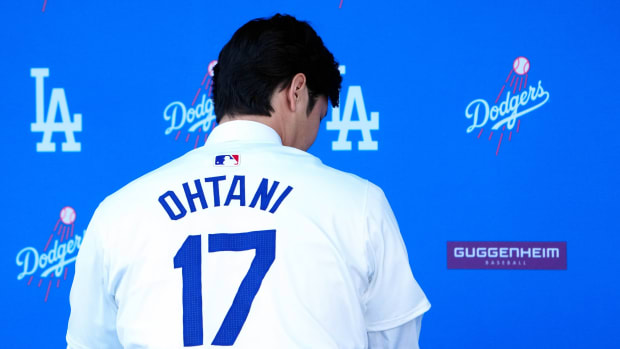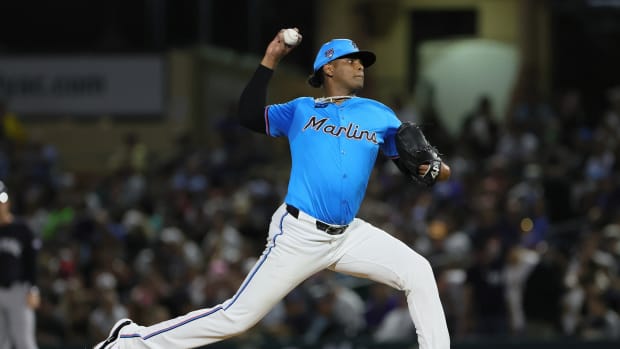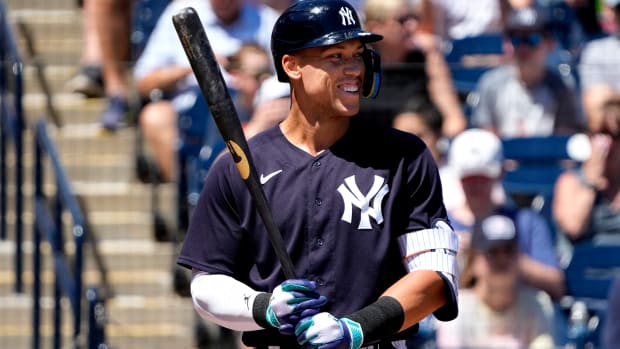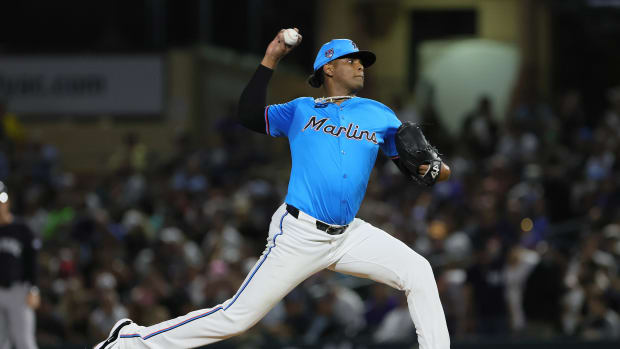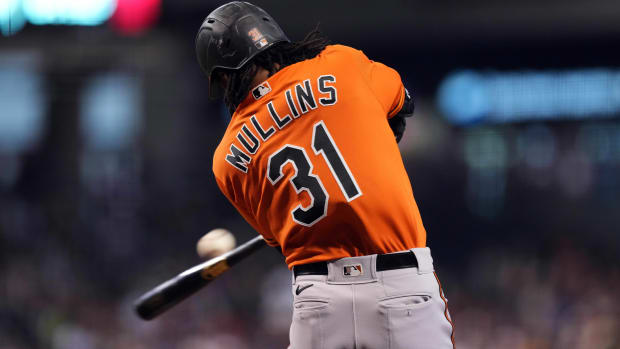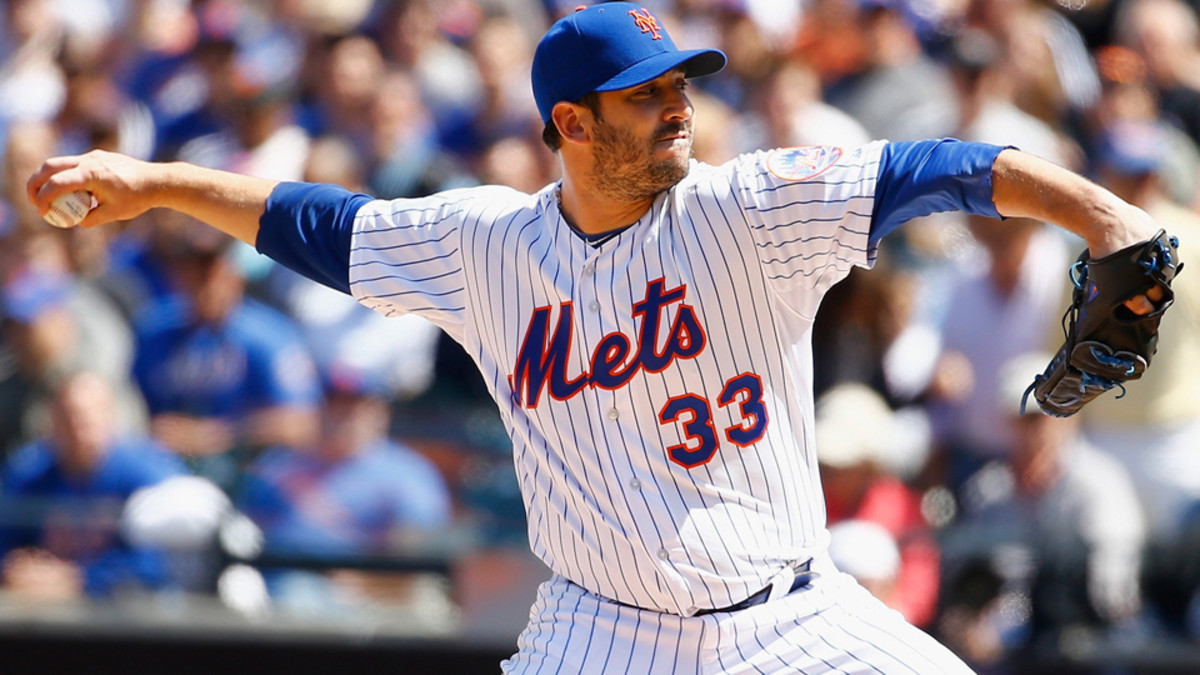
The post-Tommy John surgery calculus that is changing the game
Imagine a pitch-black room filled with porcelain vases, clay sculptures and glass tables. You have never set foot in the room before. Now you are asked to walk from one end of the room to the other. This is how baseball is proceeding with investing in pitchers who have had Tommy John surgery: Teams are taking careful, baby steps in the dark, but you just know we are on the brink of the industry’s first $100 million disaster with damaged goods.
Would you give Jordan Zimmermann seven years of guaranteed money? Would you lock up Matt Harvey today to a long-term contract extension? The answers may not be as obvious as you think.
Baseball’s rise in revenues has sparked a rush to buy up free-agent years from some of the game’s best young players, including Felix Hernandez, Clayton Kershaw, Giancarlo Stanton and Mike Trout. But one subset of players has missed out on this trend of mega-extensions: pitchers who have come back from Tommy John surgery.
Power Rankings: Tigers in first, but Dodgers, Cardinals, Mets are close
Now look at a few elite pitchers who did have Tommy John surgery who are lined up for the next four free-agent classes. After this season, you have Zimmermann. After next year: Stephen Strasburg. After 2017: Yu Darvish. After 2018: Harvey and Jose Fernandez.
There are several reasons why Porcello (77–65, 4.34 ERA at age 26) is locked up and Zimmermann (58–42, 3.28 ERA at age 28) is not, but one of the most obvious is that Zimmermann had Tommy John surgery in 2009. Now clubs, including Zimmermann’s Nationals, are skittish about how long these rebuilt ulnar collateral ligaments will hold up.
"We think it’s about seven years," said one AL talent evaluator. “Listen, we think six- or seven-year contracts for any pitcher are risky. We wouldn’t do it for a guy with a clean bill of health. So a guy who has had Tommy John surgery presents even more risk.”
Cubs' future grows brighter with call-up of top prospect Addison Russell
Tommy John surgery has been around since 1974. Years ago, it typically addressed an injury of attrition that often struck a pitcher in mid-career (Tommy John himself had it at age 31, John Smoltz at 32, Chris Carpenter at 32, etc.). But what we have seen in recent years is the average age of pitchers undergoing the surgery is getting younger and younger. Why? This is the first generation of pitchers who have grown up in the full-blown travel and showcase circuit, which often means year-long competitive pitching in which elite velocity is the driving force. Adolescent pitchers throwing harder and harder in more competitive environments in more months of the year leads to more Tommy John surgeries at a young age.
And then what?
That’s the dark room fraught with danger. Teams may believe the lifespan of a rebuilt ligament is seven to eight years, but the fact is we don’t know for sure. The data for so many pitchers getting their first surgery at such young ages is just developing. Here’s what we do know about the danger of a second blowout:
• While about 80% of initial Tommy John patients return to pitching at the same level after a first surgery, research by doctors at Henry Ford Hospital in Detroit found that a second such surgery is far more disastrous to a pitcher’s career. Only 65% returned to pitching in the majors, and those that did make it back lasted no more than three years, saw their innings and wins drop in half and had their walk rate increase by 19%.
• There have been 39 major league pitchers since 1999 that underwent a second Tommy John surgery, known as a “revision.” The average time between surgeries is 4.97 years.
• Revisions are increasing rapidly: There have been as many revisions done in just the past three years (18) as in the previous 12.
Keep in mind that these numbers are for major league pitchers only. MLB researchers have begun compiling as much data as they can on pitching injuries, but public data on minor leaguers and amateurs is limited and difficult because of privacy issues. We do know we’re seeing more Tommy John surgeries even before a pitcher is drafted. In June, we may see two recovering Tommy John patients drafted in the first round: Brady Aiken and Mike Matuella.
Zimmermann looms as an historic case: the first Tommy John survivor who could command more than $100 million. The record payday for a Tommy John survivor is the five-year, $97.5 million extension the Cardinals gave Adam Wainwright in 2013, two years after his surgery. Wainwright, though, was 29 when he underwent his surgery and already had thrown 874 1/3 major league innings. He is pitching his fourth post-surgery season this year.
Zimmermann was only 23 years old with just 91 1/3 innings under his belt when he underwent surgery in August 2009. A team that signs Zimmermann to the industry standard six- or seven-year contract for an elite pitcher (Matt Cain, Zack Greinke, Cole Hamels, Jon Lester, Justin Verlander, etc.) is betting that his rebuilt UCL will hold up for 11 or 12 years. It has happened before. David Wells pitched for 23 years after undergoing surgery as a minor leaguer in 1985, going on to win a post-surgery record 239 games. A.J. Burnett has pitched 12 seasons since undergoing Tommy John surgery, and he has twice signed five-year contracts ($55 million from Toronto and $82.5 million from the Yankees).
The difficult task for teams is to sort through all the variables (size, age, stuff, mechanics, workload, biomechanics, work ethic, etc.) to make an informed guess as to whether a pitcher like Zimmermann is more like Wells and Burnett or more like Josh Johnson, who had his second Tommy John surgery just under seven years after his first.
What debuts of former top prospects can teach us for Kris Bryant
As revenues go up, the cost of making that bet increases. Burnett, for instance, first hit free agency in 2005 after his age-28 season, with a 3.73 ERA, a 111 ERA+ and 7.9 strikeouts per nine innings. The Blue Jays plunked down $55 million that the ligament would hold up for five years. Zimmermann will hit free agency after his age-29 season, with what currently is a 3.28 ERA, a 119 ERA+ and 7.4 strikeouts per nine innings, and will be the top pitcher available one year after Max Scherzer and Jon Lester, the top two pitchers this past off-season, signed for $210 million over seven years and $155 million over six, respectively. In other words, the cost of a bet on Zimmermann will be much higher than it was for Burnett. A similar calculus will be in play for Strasburg next year, who had his surgery at age 22 in '10, meaning a six-year investment after next season is a bet on 11 years of stability for his rebuilt UCL.
The Nationals know too well how Tommy John surgeries are skewing younger and younger with this first generation of over-specialized, high-velocity young pitchers. Their list of top major and minor league pitchers to undergo the surgery before age 25 just in recent years includes Zimmermann (then 23), Strasburg (22), Lucas Giolito (18), Erick Fedde (21), Taylor Jordan (22), Sammy Solis (23) and Matt Purke (24). With Zimmermann and Strasburg, Washington may choose to take a use-it-and-lose-it approach: enjoy the five or six prime years of control after Tommy John surgery, but leave another organization to assume the risk of the next half dozen years of someone pitching in his 30s with a rebuilt UCL.
The Mets and Marlins soon will face this same decision on Harvey and Fernandez, respectively. It’s easy to say New York should lock up Harvey as soon as possible after watching his first three post-op starts this year, in which he has 24 strikeouts and one walk in 18 innings. But think about what it would take to get Harvey signed: you would have to buy up his three arbitration seasons and, as teams prefer in these cases, at least two free-agent years, which would take Harvey to his age-32 season.
The Gordometer: Can these former top prospects break out in 2015?
That scenario—signing away the prime years of his career without the leverage of free agency—is such a big concession by Harvey that the Mets would have to pay a premium (the way the Red Sox did with Porcello), rather than getting a hometown discount. Harvey’s three arbitration years before free agency are worth somewhere between $29.8 million (Zimmermann’s three-year take) and $43.85 million (David Price’s three-year haul, though Price had the leverage of an additional arbitration year prior to those three). Harvey’s first two free-agent years could be worth near the $30 million annual value of Scherzer’s contract with Washington.
Now you’re talking about $100 million over five years. What’s the most money ever given a starting pitcher heading into his first year of arbitration? The $42 million over five years the Nationals gave Gio Gonzalez in 2012.
Both Harvey and Fernandez are Scott Boras clients and eligible for arbitration for the first time after this season. Miami made a run at extending Fernandez this winter by proposing a six-year extension plus two options, which would require Fernandez to yield four free-agent years—ages 26 through 29. Nothing doing.
One Tommy John survivor who actually did sign a contract extension this month is Carlos Carrasco of Cleveland. But the price was low: just $22 million for four years plus two club options, which gives the Indians control of three free-agent years. Carrasco underwent his surgery in September 2011, which means the team is betting that his repaired ligament holds up at least seven years, or two years past the average when we see revision surgeries.
The tricky part for all clubs is that an entirely new market is being defined: the valuation of Tommy John survivors in their prime years. Much of it depends on how individual clubs define an emerging question: If a pitcher undergoes Tommy John surgery in his teens or early 20s, how long can you expect the ligament to hold up?
Pitching has changed dramatically in the past five to seven years. With the advent of specialized relief and a robust supply of hard throwers, starting pitchers now approach pitching much like a reliever: Go as hard as you can and forget about pacing yourself to face a lineup three or four times. Coupled with the chase for velocity among amateurs, we’re likely to see more blown-out elbows.
For too long people have viewed Tommy John surgery as a benign, even performance-enhancing surgery. A 2011 study found that a majority of high school players surveyed (51%) considered Tommy John surgery a good idea for pitchers even with healthy elbows! Another study found that more than one-third of parents felt the same way.
The sobering fact is that one out of every seven pitchers who undergo Tommy John surgery never will return to the same level of pitching. And when you get Tommy John surgery at a young age, you are that much closer to your second Tommy John surgery. And a second Tommy John surgery means something else for one in three pitchers: the end of the line.































